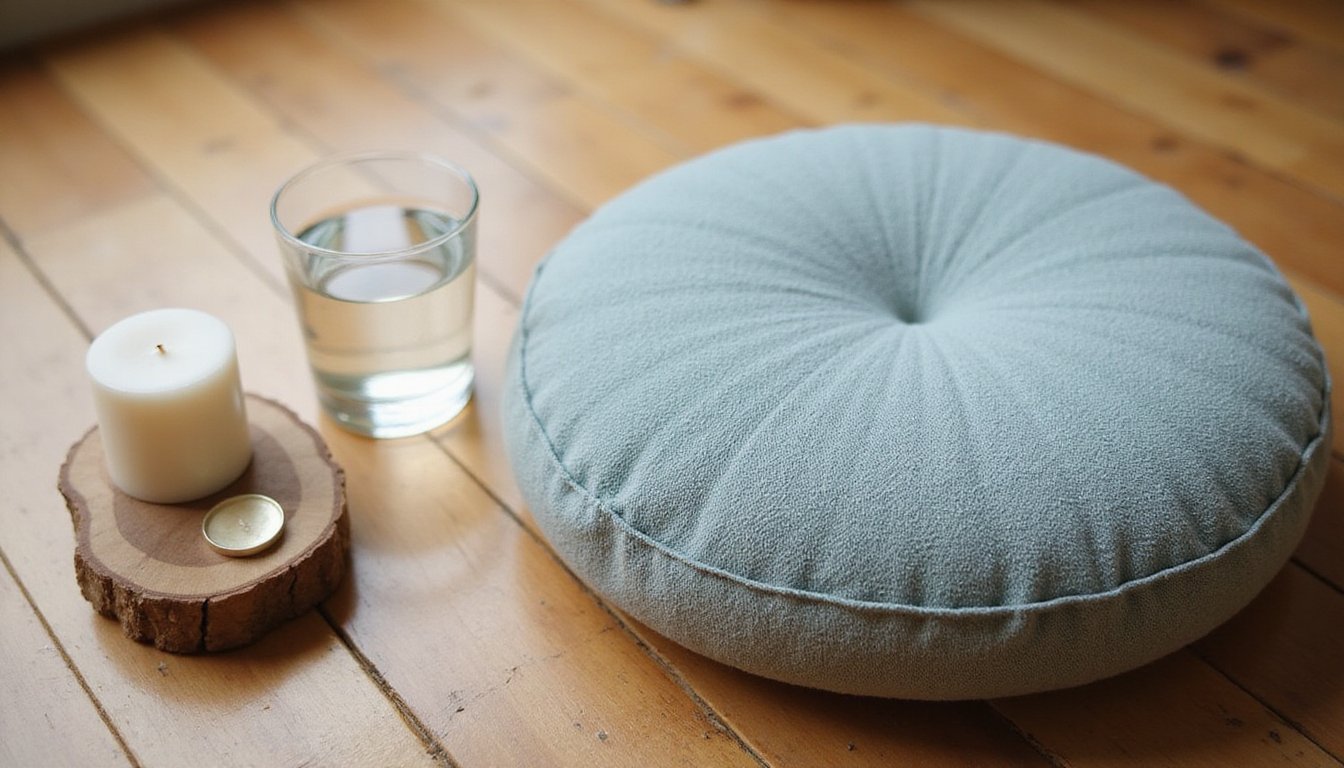Research shows that mindfulness techniques can effectively reduce anxiety by activating your prefrontal cortex while decreasing amygdala reactivity. You’ll benefit from practicing mindful breathing exercises like box breathing or diaphragmatic breathing for just five minutes daily. Focus on present-moment awareness to interrupt negative thought cycles, and employ cognitive reappraisal strategies to manage anxiety triggers. The neuroscience behind these approaches reveals powerful mechanisms for lasting anxiety relief and emotional regulation.
Understanding the Science Behind Mindfulness and Anxiety

Three key neurobiological mechanisms explain how mindfulness practices reduce anxiety. Initially, neuroimaging evidence shows that mindfulness activates your prefrontal cortex while decreasing amygdala activity, leading to better emotional control. Second, it reduces default mode network activity in your brain, which directly decreases rumination and worry patterns common in anxiety disorders. Recent studies confirm that cognitive reappraisal techniques help individuals better manage their anxiety symptoms. Third, regular mindfulness practice lowers cortisol levels and boosts cognitive control networks, making you less susceptible to anxiety triggers. Research demonstrates that these changes occur through neuroplasticity, your brain’s ability to form new neural connections. Studies comparing mindfulness to traditional anxiety medications, like escitalopram, show equal effectiveness in symptom reduction. A recent clinical trial found that both treatments achieved a 30% reduction in anxiety symptoms. This scientific evidence explains why mindfulness-based interventions have become a credible treatment option for different anxiety disorders. Research has shown that mindfulness-based stress reduction programs are particularly effective for patients diagnosed with generalized anxiety disorder.
The Power of Mindful Breathing Exercises
While many anxiety management techniques exist, mindful breathing exercises stand out as one of the most empirically validated interventions for reducing anxiety symptoms. Research shows that just five minutes of daily practice can notably improve your mood and reduce stress levels, with meta-analyses confirming small-to-medium effect sizes for anxiety reduction. Recent studies examining breathwork practices demonstrate that these techniques can be easily taught remotely. The practice of nasal breathing has been shown to significantly improve oxygen intake and coordination of brain signals related to emotion regulation.
Different breathing patterns affect your physiology in distinct ways. Cyclic sighing, which involves a double inhale followed by extended exhale, demonstrates the strongest impact on positive mood. Box breathing and diaphragmatic breathing activate your parasympathetic nervous system, lowering your breathing rate and dampening fight-or-flight responses. The shortage of therapists has made these self-administered techniques increasingly valuable for managing mental health. You’ll find these techniques particularly accessible, as they require no special equipment and can be practiced anywhere. Studies confirm that consistent practice, even through online guidance, strengthens these benefits over time.
Developing Present-Moment Awareness

Present-moment awareness serves as a cornerstone of effective anxiety management, with strong evidence supporting its capacity to improve emotional well-being and cognitive function. Through nonjudgmental observation of your thoughts and experiences, you’ll interrupt negative thought cycles that fuel anxiety and stress.
Research shows that cultivating present moment attunement amplifies your emotional resilience and self-awareness, allowing you to regulate responses more effectively. Studies indicate that mind wandering occurs nearly half of our waking hours. You’ll notice improvements in attention, concentration, and decision-making as you learn to redirect focus away from distractions. This practice also fortifies your relationships through better listening and authentic communication. Maintaining a clean eating pattern can enhance your mental clarity and make it easier to stay present with your experiences. By learning to defuse from worries about past and future events, you can experience greater mental peace in your daily life.
Breaking Free From Worry Cycles
You can begin breaking free from worry cycles by learning to identify your specific thought pattern triggers, such as work deadlines, social situations, or health concerns. When you notice these triggers activating, you’ll benefit from implementing a mindful pause, a brief moment where you consciously step back from the escalating thoughts. This intentional pause creates space between the trigger and your response, allowing you to engage your rational mind rather than defaulting to automatic worry patterns. Research shows that emotional processing biases can make negative thoughts more likely to intrude into awareness, making this mindful pause especially important. Understanding these patterns as part of the anxiety cycle stages can help you recognize when you’re entering into avoidance behaviors and take corrective action. Using healthy coping strategies like deep breathing exercises and meditation can provide temporary relief while working to confront anxiety-inducing situations.
Recognize Thought Pattern Triggers
Understanding how to recognize thought pattern triggers marks a crucial initial step in breaking free from anxiety-driven worry cycles. Through meta-cognitive observations, you’ll learn to identify specific patterns like catastrophizing, rumination, and hypervigilance that activate your stress response system. Emotion regulation strategies have shown particular effectiveness in managing anxiety symptoms.
Research shows that thought labeling strategies help you separate yourself from anxious thinking, reducing amygdala activation and cortisol production. Studies demonstrate that individuals with higher trait mindfulness exhibit enhanced executive functioning and cognitive control when managing anxious thoughts. By monitoring your thoughts without judgment, you’re better equipped to recognize when worry cycles begin. The practice emphasizes present-moment awareness rather than dwelling on past events or future worries. Neuroimaging studies confirm that mindful awareness decreases emotional reactivity in the brain’s anxiety centers.
You can track these patterns using thought journals while implementing brief mindfulness interventions, which have demonstrated significant efficacy in reducing worry frequency. This evidence-based approach enables you to interrupt automatic responses before they escalate into persistent anxiety states.
Practice Mindful Pause Techniques
Three foundational techniques form the cornerstone of mindful pause practices: the STOP method, breath-focused attention, and body awareness scanning. You’ll find these evidence-based approaches particularly effective for proactive anxiety management, as they’re designed to interrupt reactive worry cycles before they escalate.
When you implement daily mindful pauses, even for just 30 seconds, you’re activating your relaxation response while reducing amygdala activity. The STOP technique (Stop, Take a breath, Observe, Proceed Mindfully) helps you break free from automatic reactions, while focused breathing and body scanning create a strong present-moment anchor. Research shows these methods substantially reduce anxiety symptoms and improve emotional regulation when practiced consistently. You can apply these techniques anywhere, making them invaluable tools for managing high-pressure situations and building lasting emotional resilience.
Building a Daily Mindfulness Practice

To establish an effective mindfulness practice, you’ll want to begin with just 10 minutes daily and build from there, as research shows consistent short sessions yield significant anxiety reduction. You can strengthen your habit by anchoring practice to existing daily routines, such as morning coffee, lunch breaks, or bedtime preparation. Creating a dedicated space for your practice, even if it’s just a specific corner with a cushion, will help reinforce the ritual and improve your adherence to daily meditation.
Start Small, Build Consistency
Building a sustainable mindfulness practice begins with small, manageable commitments rather than ambitious goals. Research shows that starting with just 5-10 minutes daily leads to considerable reductions in anxiety and depression within 30 days, with participants experiencing a 19.2% decrease in depressive symptoms and 12.6% reduction in anxiety levels.
To build consistency, you’ll benefit from leveraging digital reminders and environmental cues. Set up smartphone notifications, designate a specific meditation space, and link your practice to existing daily routines. Studies demonstrate that utilizing meditation apps with 10-minute guided sessions dramatically improves adherence rates and overall well-being outcomes. Track your progress through app features or journaling, as data shows that monitoring your practice reinforces commitment and helps sustain long-term engagement with mindfulness exercises.
Choose Your Anchor Moments
Selecting strategic anchor moments throughout your day creates a sustainable foundation for mindfulness practice. By attaching mindfulness to existing routines like brushing teeth, commuting, or shifting between tasks, you’ll establish reliable cues that prompt present-moment awareness.
Research shows that utilizing environmental cues and context-based practices considerably enhances the sustainability of mindfulness habits. Consider placing visual reminders in key locations or using specific sounds as prompts. Your breath serves as a portable anchor, particularly during stressful situations, while sensory awareness exercises help ground you in the present moment.
Focus on natural points of change between activities to integrate brief mindful pauses. These intentional breaks activate regions of the brain associated with emotional regulation and help reduce anxiety by interrupting automatic stress responses.
Create Sacred Practice Space
Creating a dedicated mindfulness space sets up powerful environmental cues that reinforce your daily practice. Choose a quiet corner of at least 4×4 feet, ideally near natural light from east or north-facing windows. Install lighting considerations, such as dimmer switches or warm-toned bulbs to support relaxation during different times of day.
Focus on curating personal items that hold meaning while maintaining minimalism. Select a comfortable meditation cushion or mat, and incorporate sound-absorbing elements like rugs or wall hangings to minimize external distractions. Add carefully chosen sensory elements, perhaps essential oils, plants, or a small water feature, to amplify your practice environment. Keep the space clutter-free and dedicated solely to mindfulness activities, as this singular purpose strengthens the neurological associations that support your ongoing practice.
Group Meditation Benefits and Support
Research demonstrates that group meditation yields substantial benefits for anxiety reduction, with 72% of studies showing statistically significant improvements in anxiety symptoms compared to control groups. Through social engagement and peer-to-peer learning, you’ll gain an enhanced understanding of mindfulness techniques while building valuable support networks.
Group sessions offer unique advantages over individual practice. You’ll receive real-time feedback from facilitators, observe proper meditation techniques directly, and learn from others’ experiences. The structured environment promotes consistent attendance and practice habits, which are essential for managing anxiety long-term.
You’ll also benefit from increased motivation and accountability within the group setting. Studies show that participants in group meditation programs report higher levels of perceived social support and demonstrate better adherence to mindfulness practices compared to those practicing alone.
Cultivating Self-Acceptance Through Mindfulness
Developing self-acceptance through mindfulness begins with recognizing and observing your thought patterns without judgment. Research shows that fostering self-kindness through mindfulness-based interventions drastically reduces anxiety and depression while integrating acceptance of your thoughts and emotions.
| Mindful Aspect | Psychological Impact | Brain Changes |
|---|---|---|
| Non-judgmental Awareness | Reduced Self-criticism | Lower Amygdala Activity |
| Present Moment Focus | Augmented Flexibility | Increased Gray Matter |
| Self-compassion | Decreased Anxiety | Better Emotion Regulation |
| Thought Observation | Improved Metacognition | Reduced Self-referential Processing |
| Acceptance Practice | Lower Experiential Avoidance | Greater Prefrontal Control |
You’ll develop greater psychological flexibility as you practice mindfulness, allowing you to respond more adaptively to stressors. Meta-analyses confirm that regular mindfulness practice incorporating self-compassion leads to sustained improvements in mental well-being and anxiety reduction.
Practical Mindfulness Tools for Immediate Relief
A range of practical mindfulness tools offers immediate relief from anxiety symptoms through structured, evidence-based techniques. When you need quick fix strategies, start with the 3-3-3 rule: identify three objects, sounds, and textures in your environment to break the anxiety cycle. Deep breathing exercises, performed for just five minutes, can activate your parasympathetic nervous system and reduce heart rate.
Consider contextual considerations when choosing your approach. Progressive muscle relaxation can be adapted for busy settings, requiring only 2-5 minutes to release physical tension. For tech-supported options, guided meditation apps provide structured sessions and body scans. You’ll find these tools most effective when practiced regularly, as research shows consistent use can rewire stress reactivity patterns and improve emotional regulation over time.
Frequently Asked Questions
How Long Does It Take to See Results From Regular Mindfulness Practice?
You’ll notice initial benefits from consistent practice duration within just 4 weeks of daily mindfulness sessions. Research shows 10-minute daily sessions can reduce anxiety by 12.6% and depression by 19.2% after one month. The noticeable improvement timeline accelerates with longer 20-minute sessions, and benefits accumulate profoundly over 8 weeks. For ideal results, maintain regular practice, as studies demonstrate amplified outcomes at 3 months, 1 year, and beyond.
Can Mindfulness Meditation Be Harmful or Worsen Anxiety for Some People?
Yes, mindfulness meditation can have potential negative effects for some people. While generally safe, you may experience temporary increased anxiety, especially if you have pre-existing conditions like trauma or severe anxiety disorders. Research shows that about 87% of practitioners encounter momentary discomfort, and 25% report persistent effects. However, serious adverse events are rare and typically occur only in intensive, unsupervised practice. It is crucial to start with qualified guidance and proper screening.
What Should I Do When Mindfulness Feels Impossible During Panic Attacks?
When mindfulness feels overwhelming during panic attacks, switch to simpler breathing exercises like counting your exhales or basic relaxation techniques such as progressive muscle relaxation. You’ll find it helpful to focus on concrete sensory experiences, touch a textured object or name items you can see. Don’t force complex mindfulness; instead, practice “micro-mindfulness” by bringing awareness to just one sensation at a time until your symptoms begin to subside.
Is It Necessary to Sit Still While Practicing Mindfulness Techniques?
No, you don’t need to sit still to practice mindfulness. Research confirms you can achieve similar benefits through movement-based practices like walking meditation or informal mindfulness during everyday activities. You’ll find that mindfulness works effectively whether you’re in motion or stationary. Your practice can include mindful walking through nature, gentle stretching, or even paying attention to your movements while doing household chores or commuting.
How Do I Know if I’m Doing Mindfulness Exercises Correctly?
You’ll know you’re practicing mindfulness correctly when you experience physical indicators like muscle relaxation and a slower heart rate. Pay attention to your ability to maintain proper breathing techniques without getting caught up in thoughts. While it’s normal to encounter distractions, you should be able to recognize them and gently return your focus to the present moment. Positive signs include reduced anxiety after sessions and increased ability to observe experiences without judgment.







